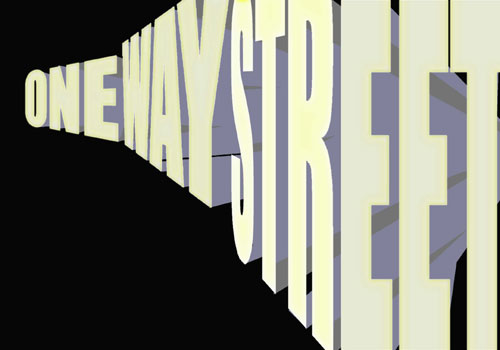One Way Street

ONE WAY STREET
Sheppard Fine Arts Gallery
Reno
2007
Video works by: Amanda Beech, Pierre Bismuth, Jaspar Joseph-Lester, Mark
Leckey, Roman Vasseur
Curated by: Amanda Beech, Jaspar Joseph-Lester, Matthew Poole
One Way Street is an exhibition of five international artists working
with video:
Amanda Beech, Pierre Bismuth, Mark Leckey, Jaspar Joseph Lester, Roman
Vasseur.
The exhibition is part of a long-term research project between Dr. Amanda
Beech (Director of MA
Critical Writing Curatorial Practice, Chelsea and Wimbledon Colleges of
Art, UAL, London, UK), Dr.
Jaspar Joseph-Lester (Leader of MA Contemporary Art Curating, Sheffield
Hallam University, UK),
and Matthew Poole (Director of MA Gallery Studies and Critical Curating,
University of Essex, UK).
The show will tour to KX Gallery, Hamburg, Germany in October, 2007
A site-specific environment transforms the gallery into a space of disorientation
and spectacle.
Reclaiming the design work of Kurt Schwitters’ “Merzbau -
Cathedral of Erotic Misery”, 1923-43, and
the mechanics of the moving but essentially static stage sets of classic
Hollywood and postmodernity,
the exhibition manifests video as parts of its architecture and vice versa.
The exhibition draws upon
the notions of cinematic space as an architectural (monumental) field,
our social lives as a cinematic
territory, and the violence and pleasure of constructing “meaning”
within this democratic space.
The title of the show takes its cue from Walter Benjamin’s text
of the same name.1 Benjamin’s text
intermingles a series of disjointed narrative spaces, scenarios, theories
and memories. Throughout the
text we experience the collapse between the monumental, ideological space
of architecture and the
spectacle of cinema. Architecture is now temporal fleeting and unfixed
from time; a set of cinematic
fictional encounters. Fleeting ‘cinematic’ images become dark
spectral scenes that take on the
orthodox ideological power of architecture; they become monuments. This
world of phantasmagoria
is now constituted by the force of subjectivities that construct and determine
meaning. Within this
collapse of ideological parameters, the site for experiencing what we
determine to be ‘reality’ is
constituted by violence, power and pleasure. Acknowledging and attributing
this Benjaminian sphere
of experience in its selected artworks and in its curatorial frameworks,
the exhibition asks in what
way does contemporary western culture live with, produce and experience
constructed fictions as
empirical reality?
The artworks significantly attest to this experience of violence and pleasure.
The works are
episodic, mythic and they capture the language and experience of determinacy
through the temporality of
video - there’s no end in sight, and nowhere to turn either.
Amanda Beech’s “State Line”, 2007, filmed at the Cal
Neva Lodge, Lake Tahoe, infamous for its
Mafioso and Kennedy family connections, embodies the violence of liberalist
individualism, where
mobile subjectivities articulate the force and the site of law.
Pierre Bismuth’s “Respect the Dead”, 2001-2002, consists
of feature films edited so that the film
sequences are cut immediately after the first death occurs on screen.
Jaspar Joseph-Lester’s "Spirit" 2007 focuses on a small
housing community in Dornach,
Switzerland. In the video the relation between spaces of work, home and
leisure are dominated by a
vernacular of auratic and pseudo-ritualistic architectural forms.
Mark Leckey’s “Made in 'Eaven”, 2004, shows the pristine
surface of American artist Jeff Koons'
“Rabbit” sculpture, whose contours reflect a warped and inflated
version of the artists’ flat.
Roman Vasseur’s "Black Propaganda at Melancholy Ranch",
2005, reports and dramatises a
remote event in a desert setting where a light plane breeches the uninhabited
landscape and
bombards the terrain with leaflets simultaneously reporting and threatening
a language bomb.